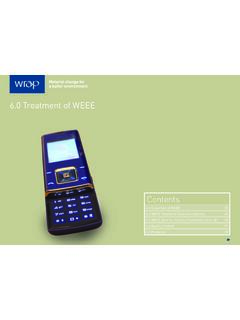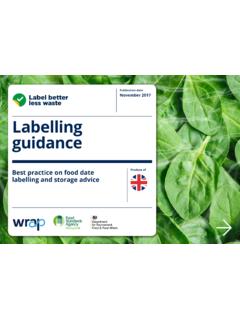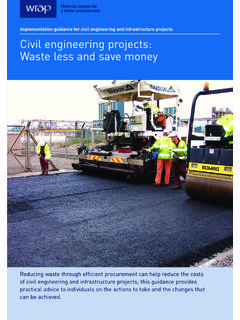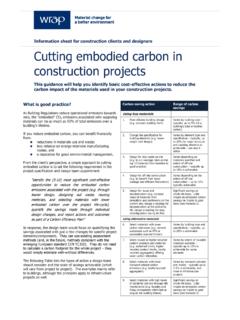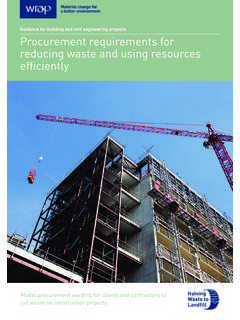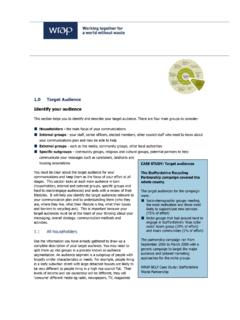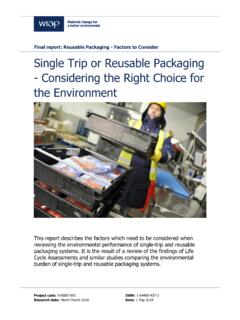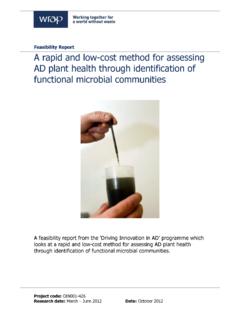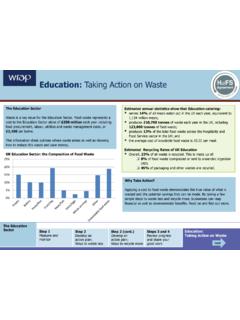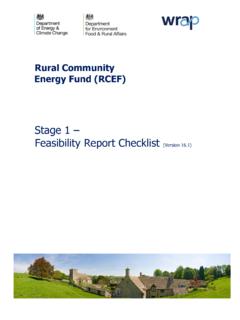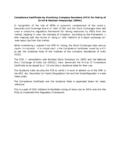Transcription of 8.0 Export of Whole WEEE and WEEE Derived …
1 weee Treatment Good Practice guidance Export of Whole weee and weee Derived Export procedures Export of weee and weee Derived Materials Export for Reuse 05 weee Treatment Good Practice guidance 1 When weee from an obligated source is exported it must be done through an Approved Exporter (AE). When an item has been refurbished and is fit for reuse it can be exported using typical Export procedures. However, in order to be able to raise evidence on the item it must be exported by an weee is exported for further treatment, the AE should ensure that the recipient treatment facility operates to a standard that is equal to that of a UK facility. This section of the guidance provides initiatives treatment facilities can implement to ensure they are legally compliant when exporting Export proceduresExporters can only issue evidence of weee treatment or recovery if they have been approved as an AE by the relevant authority (Environment Agency, Scottish Environment Protection Agency or Northern Ireland Environment Agency) under the weee Regulations.
2 This registration allows the facility to issue weee evidence notes for exported Whole obligated household weee . AEs should have a system in place that can provide confirmation to treatment facilities that the exported Whole weee was received and treated or recovered by the overseas AE must keep a record of all exports of weee and ensure that treatment or recovery overseas is undertaken to standards equivalent to those set out in the weee Regulations. Audience: This section of the guidance is aimed at all organisations involved in the Export of weee such as treatment facilities, Approved Exporters (AE), and haulage : The benefit of implementing the guidance outlined below is that it can help ensure organisations involved in the Export of weee do so in a manner which is legally compliant. It also helps improve the traceability of weee to end : There is a high proportion of weee , weee Derived materials and reuse weee exported from the UK for further treatment or to supply overseas end markets.
3 When using Export markets, treatment facilities should use legally compliant Export procedures Export of weee and weee Derived Materials Export for Reuse 05 weee Treatment Good Practice guidance 2At the end of every compliance period, AEs are required to have independent audits conducted to validate the evidence they have issued, if it is in excess of 400 tonnes. Evidence notes should confirm: the amount and type of weee that the AE received for treatment; and that the AE has passed them through customs for weee has been treated before Export , then the original AATF will issue the evidence. Thereafter, the treatment facility must use an AE to undertake the Export of the treated (or partially treated) weee . All exports must be carried out in accordance with the Waste Shipment Regulations (WSR) and UK Transfrontier Shipments of Waste Regulations (TFS) should provide confirmation to the treatment facility that the material has been exported and that it will be recovered overseas to the necessary equivalent UK standards.
4 There is a two stage process to be completed before weee may be exported. The first stage is to categorise the type of weee or weee Derived materials by checking the relevant Waste Shipment Regulation s (WSR) Annexes (Annex III and IV) with the referent weee categorisation, and then checks should be conducted to identify whether the weee is prohibited or permitted for Export for recovery. If the weee or weee Derived materials are eligible for Export , the second stage in the process should be followed, which requires the treatment facility to refer to specific requirements within Annexes III and IV of the WSR where the weee or weee Derived materials are categorised. This means that if weee is not categorised within Annex III, its Export will be subject to the procedure of prior written notification and consent referred to in the WSR. For weee listed in Annex III, the specific requirements will depend on the waste category and the country of information including the Annexes list can be found here.
5 Or visit weee should only be exported through Approved Exporters (AEs) as this will allow them to issue evidence when exporting materials and or items. However when weee is non-obligated it can be exported through conventional Export procedures. Good practice would be to use AEs for all weee exports to ensure that valid overseas treatment routes are facilities should ensure that organisations they intend to use for exporting are actually registered as AEs and check with the relevant enforcement body if they do not appear on the public register. By undertaking these checks, the treatment facility can be confident that their materials / items are being legally exported by regulated approved exporters. Where practical, site visits should be arranged to identify what happens to the weee . 1 Legal requirements from the destination countries are found in the EC 1418/2007, EC 740/2008 and EC 967 Export procedures Export of weee and weee Derived Materials Export for Reuse 05 weee Treatment Good Practice guidance Export of weee and weee Derived materialsTreatment facilities that use exporters to organise the treatment of weee outside the UK must use AEs to ensure they can issue evidence notes for that weee is banned from Export for recovery to countries outside the Organisation for Economic Cooperation and Development (OECD).
6 Examples of weee considered hazardous include those that contain components or substances which are classified as hazardous under the European Waste Catalogue (EWC) list, such as the following: polychlorinated biphenyls (PCBs); ozone depleting substances (ODS) ( fridges and freezers); asbestos; cadmium; lead; and cathode ray tubes (CRTs), found in televisions and older computer monitors. The exporter should also ensure they comply with the national legislation in destination countries. Each destination country may require a different procedure, depending on the type of waste it receives. The AE should develop a list of reprocessors they use in Export destinations with their legal import requirements, and keep it available for any treatment facility or PCS to review. This will help the AE keep their legal requirements up to date and raise its profile amongst stakeholders, such as PCSs, other AATFs and the EA.
7 However it should be noted that this information can be commercially sensitive and should be treated as exporting weee for treatment or recovery the AE should ensure that: the overseas facility operates to standards equal to a UK ATF or AATF; and the overseas facility operates in accordance with any permits required in that country. If weee is treated prior to Export , then it is the original AATF that issues the weee evidence and an AE must be used to Export the AE must provide confirmation to the AATF that the weee ( Whole weee or components) has been exported and will be treated or recovered overseas to the required UK standards. AATFs / AEs are required to issue evidence of the tonnages of weee received (by category) and the level of recovery, recycling or reuse achieved when all treatment processes have been completed. This is the amount of weee materials that you have delivered or had delivered on your behalf by another ATF, and received by a reprocessor or to an approved Export procedures Export of weee and weee Derived Materials Export for Reuse 05 weee Treatment Good Practice guidance 4 Good practiceInitiatives considered good practice in exporting weee (including for reuse) and weee Derived materials include: tracking weee (including reuse) and weee Derived materials to their final destination, which may include site audits (where practical).
8 All records should be retained in an auditable manner to enable assessment bodies to verify the process. By doing this the treatment facility can ensure the traceability of their weee . Where this is not feasible, such as with metals or plastics, which are traded commodities the AATF / AE should ensure that they are shipped to approved destinations; requesting recycling percentage (where possible) and final destination evidence from AEs ensures that reported recycling percentages are accurate; and working with a manageable number of AEs or Export destination treatment facilities. This ensures that the treatment facility can implement traceability systems and conduct audits, to make sure the Export organisations with which they are working are adopting treatment standards of equal merit to their own. It also helps treatment facilities monitor the final destination of their weee (including reuse) and weee Derived Export procedures Export of weee and weee Derived Materials Export for Reuse 05 weee Treatment Good Practice guidance Export for reusePriority should be given to UK markets for reuse items, however where these don t exist Export markets can be considered.
9 An example of this can be that items are fit for reuse but are not considered desirable in the UK is CRT televisions, which are becoming less popular than flat screen televisions. The benefits of exporting reuse items include: reuse is higher up the waste hierarchy than recycling; for some items reuse is not possible in the UK; and affordable items sold in Export of exporting items for reuse include: there may be a lack of waste management infrastructure in Export destination for dealing with the item at the end of life; items which are actually weee being illegally exported as EEE; life expectancy of item may be short; and potential for damage in help prevent any illegal activity when exporting items for reuse, treatment facilities should consider the following approach: where viable end markets and demand for Whole reuse appliances do not exist within the UK, the Export of fully tested and functioning equipment should be done within the EU.
10 The benefit of this is that it stays within countries that are also implementing the requirements of the weee Directive and may have better regulated treatment facilities in place than those outside the EU; and where viable end markets and demand for Whole reuse appliances does not exist within the EU, the Export of fully tested and functioning equipment outside the EU could then be treatment facility should be completely satisfied that the equipment is fully tested and repaired to full functionality and adequate records and audit trails are kept and maintained. The equipment must be handled, treated and packaged as a product, as detailed in Treatment for Reuse section exporting EEE or components to other countries for reuse, the treatment facility should ensure it is done in a manner which is compliant with all applicable UK legislation, such as technical standards, labelling, and health and safety requirements.
